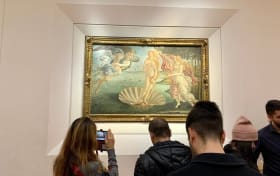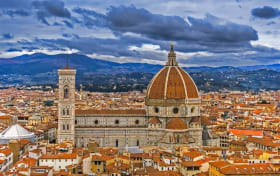Offer: Florence Uffizi Gallery, Palazzo Pitti and Boboli Gardens Tickets (5-day pass)
About this activity
Smartphone tickets accepted
- Your booking is confirmed immediately
Experience Highlights
In this activity you will have the opportunity to skip the queue and visit 3 of the most emblematic places in Florence, without waiting. In the Uffizi Gallery, you can admire some of the most important works in the history of art, such as Botticelli's The Birth of Venus, Caravaggio's Head of Medusa and Michelangelo's David.
You can tour the Renaissance-style Palazzo Pitti . Throughout its 500-year history, it has served as the residence of Florentine bankers, dukes, kings of Italy and Napoleon Bonaparte himself. Finally, in the Boboli Gardens, you can contemplate the majestic architecture, fountains and sculptures of one of the most beautiful urban gardens in the world . An ideal activity for lovers of culture, beauty and art.
- Tour the Uffizi Gallery and admire some of the most important works of art history.
- Visit the Pitti Palace and contemplate the works of art on the walls that have hosted kings and emperors.
- Stroll through the Boboli Gardens, one of the most ambitious and beautiful urban designs in history .
- You'll have 5 days to visit everything at your own pace with this pass which also gives you access to two of the city's museums: the National Archaeological Museum and the Museo Opificio delle Pietre Dure.
What’s included
- Queue-free entrance to the Uffizi Gallery
- No queuing at the Pitti Palace
- Queue-free entrance to the Boboli Gardens
- Queue-free entry to the National Archaeological Museum
Select date and time
Plan to arrive at least 15 minutes before your start time to ensure everything runs smoothly
Step by Step
Skip the line and visit the three most iconic sights in all of Florence without waiting in line. With this 5-day pass you'll have access to the city's key sights so you can visit them all at your own pace.
You'll see the Uffizi Gallery, a majestic palace which houses one of the oldest and most important collections in the history of world art. With two million visitors a year, it is the most visited art gallery in Italy.
It was built between 1560 and 1581 and opened to the public in 1765. It houses many famous works of art, such as Botticelli 's The Birth of Venus , Caravaggio 's Head of Medusa , Fabriano 's Adoration of the Magi, and Titian' s Venus of Urbino, among others. It is also famous for housing Michelangelo's David, the colossal marble statue sculpted by the Italian genius.
You will also tour the Pitti Palace, a Renaissance palace located in the centre of the city, very close to the Ponte Vecchio . The palace was built by a Florentine banker and throughout its 500-year history, it has been home to the grand dukes of Tuscany, a military base for Napoleon Bonaparte and the residence of the kings of Italy . Today, it is an art museum, which houses a famous collection of paintings, porcelain, costumes and carriages, among other works.
The third major attraction is the Boboli Gardens, which, at 45,000 square metres, are the largest green area in the whole of Florence. The gardens were built by the Medici family when they bought the Pitti Palace in 1550. They were not opened to the public until 1766. The Boboli Gardens are famous for their abundance of grottoes, fountains, pergolas and marble statues. There is also a small lake, as well as an Egyptian obelisk, which was brought from the Medici Villa in Rome .
In addition to all this, you will also have access to two museums that will complete the experience: the National Archaeological Museum and the Museo Opificio delle Pietre Dure.
Please note that the date and time chosen at the time of booking is for the Uffizi Gallery visit. During the following 5 days, you can visit the rest of the attractions at your own pace.
This tour, full of art, history, culture and nature, is ideal to learn about the history of Florence, admire its beauty, and understand the aspects of one of the most important periods in the history of world art: the Italian Renaissance.












